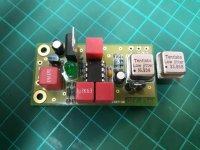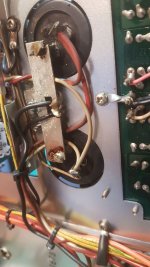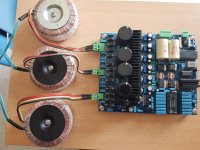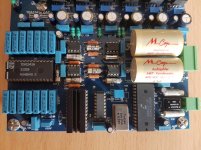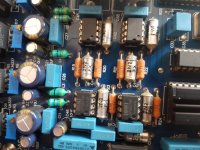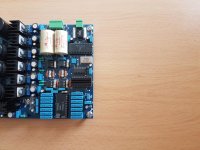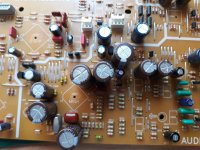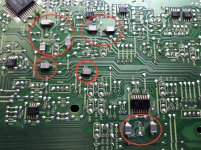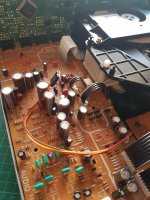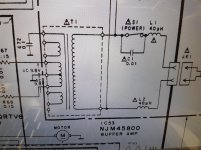Hello StewartH3,
Yes, and the answer is simple and complex:
The perfect starting point is always with a new unit, but this is not possible with a cd player manufactured in 1993 (25 years), so I try to get as close as possible. That's why I have three units, because I want a unit in a cosmetic and functional state like new. Dismantle, clean thoroughly and oily. That is my starting point.
Then I replaced all the power capacitors, and updated the operational ones. Then I install a new clock, I put a photo.
Little else has to be done with the player.
Yes, and the answer is simple and complex:
The perfect starting point is always with a new unit, but this is not possible with a cd player manufactured in 1993 (25 years), so I try to get as close as possible. That's why I have three units, because I want a unit in a cosmetic and functional state like new. Dismantle, clean thoroughly and oily. That is my starting point.
Then I replaced all the power capacitors, and updated the operational ones. Then I install a new clock, I put a photo.
Little else has to be done with the player.
Attachments
Hello StewartH3,
The issue of capacitors is simple:
If the player is 25 years old and the capacitors are within the fantastic specifications by the manufacturer, it says a lot about it.
But we can not expect them to last another 25 years, with 50 years behind them the thing is more complicated. I am 52 years old and I am in my prime, but with 77 years old (52 + 25), I will not be able to undertake this task, but I will be able to enjoy its sound.
The matter of the laser pickup is even simpler. I keep 5 new laser pick-up in stock (S0AD70) with which that part is also solved. And with two more players as donors, this is a long-term project.
This player is fantastic, it has everything ... double source with separate transformers for audio and mechanics, first components and a bomb-proof laser, remember its equivalent in Sony, KSS-151 that is impossible to achieve without having to donate an organ
Try to get one while you can. It is my advice.
The issue of capacitors is simple:
If the player is 25 years old and the capacitors are within the fantastic specifications by the manufacturer, it says a lot about it.
But we can not expect them to last another 25 years, with 50 years behind them the thing is more complicated. I am 52 years old and I am in my prime, but with 77 years old (52 + 25), I will not be able to undertake this task, but I will be able to enjoy its sound.
The matter of the laser pickup is even simpler. I keep 5 new laser pick-up in stock (S0AD70) with which that part is also solved. And with two more players as donors, this is a long-term project.
This player is fantastic, it has everything ... double source with separate transformers for audio and mechanics, first components and a bomb-proof laser, remember its equivalent in Sony, KSS-151 that is impossible to achieve without having to donate an organ
Try to get one while you can. It is my advice.
Capacitor can diameter is a determinant of cap life...ie larger caps seal better than small caps.If the player is 25 years old and the capacitors are within the fantastic specifications by the manufacturer, it says a lot about it.
Yes, including MASH oversampling processing, to my ear not so good because of sounding bright and artificial, YMMV.This player is fantastic, it has everything ...
Dan.
Thanks StewartH86
Another good thing about this player is that you do not need materials that are no longer available for a correct laser pickup, here only two settings with an oscilloscope.
In the SL-P333 - SL-P999 series it is impossible to make a correct adjustment without the adjuster of servo gains and test discs, which are no longer available.
None of that is necessary here.
Another good thing about this player is that you do not need materials that are no longer available for a correct laser pickup, here only two settings with an oscilloscope.
In the SL-P333 - SL-P999 series it is impossible to make a correct adjustment without the adjuster of servo gains and test discs, which are no longer available.
None of that is necessary here.
Hello Max Headroom
I could agree with the observation about the size of the capacitors, but they are chemical components and degrade over time, for example last Saturday I repaired a friend a Marantz 1040 old amplifier, 40 years old, and this is What I found, is normal for his age. They are condensers of 35X50 (4700 uf) the problem is the time.
I could agree with the observation about the size of the capacitors, but they are chemical components and degrade over time, for example last Saturday I repaired a friend a Marantz 1040 old amplifier, 40 years old, and this is What I found, is normal for his age. They are condensers of 35X50 (4700 uf) the problem is the time.
Attachments
Hello Max Headroom
Some observations:
- The MASH is only a commercial name for the same technology. DELTA-SIGMA that exceeded the limitations of linear dac. Philips had a winning horse, the TDA1541A, with superb and dark sound (not bright to his ears, surely) but left behind by the BITSTREAM, another commercial name for the same technology as the MASH, and so the rest of manufacturers. They are all MASH with another name.
- Why? because the increase of bits (by marketing) leads to an increase in complexity and costs difficult to assume by the industry.
- What can I do, if I want a not so "bright" sound to install one or several TDA1541A in my system, in the form of external DAC possibly with dual op / tube output.
- Another thing to consider is never, never, never buy the Chinese TDA1541A or NOS sellers, always buy old players and extract the chip. The same for the components, use vendors like Farnell ... etc.
- Note that Lampizator praised TDA15141A in his "amateur" projects, as the best DAC, but when he set up his company, he realized that he could not get them in the right amount, and most importantly for many years, so installs on your DAC products based on the BUFALO SABLE chip, another "MASH" or DELTA-SIGMA, if you prefer.
For my part I am going to add this other external DAC to my project:
Some observations:
- The MASH is only a commercial name for the same technology. DELTA-SIGMA that exceeded the limitations of linear dac. Philips had a winning horse, the TDA1541A, with superb and dark sound (not bright to his ears, surely) but left behind by the BITSTREAM, another commercial name for the same technology as the MASH, and so the rest of manufacturers. They are all MASH with another name.
- Why? because the increase of bits (by marketing) leads to an increase in complexity and costs difficult to assume by the industry.
- What can I do, if I want a not so "bright" sound to install one or several TDA1541A in my system, in the form of external DAC possibly with dual op / tube output.
- Another thing to consider is never, never, never buy the Chinese TDA1541A or NOS sellers, always buy old players and extract the chip. The same for the components, use vendors like Farnell ... etc.
- Note that Lampizator praised TDA15141A in his "amateur" projects, as the best DAC, but when he set up his company, he realized that he could not get them in the right amount, and most importantly for many years, so installs on your DAC products based on the BUFALO SABLE chip, another "MASH" or DELTA-SIGMA, if you prefer.
For my part I am going to add this other external DAC to my project:
Attachments
Sure, 40 years would be the outside limit for any rubber bung sealed cap I should think.
I am trying to draw attention to the fact that most caps are still fine well after 20+ years, and the failures start with small diameter caps and/or such caps in proximity of high heat sources......the classic dumb design is 5mm electros right next to regulators, Duh.
Novices are replacing far too many caps by blind substitution and probably causing reduced 'second life'.
Dan.
I am trying to draw attention to the fact that most caps are still fine well after 20+ years, and the failures start with small diameter caps and/or such caps in proximity of high heat sources......the classic dumb design is 5mm electros right next to regulators, Duh.
Novices are replacing far too many caps by blind substitution and probably causing reduced 'second life'.
Dan.
Right, but I'm not a "novice" I've been doing this for 32 years, and you have to have my own life cycle, if I replace them after 26 years, it's because I may not see myself doing it in another 15 years, by then I hope to enjoy the music that is the objective. true?
Personally I love what I understand, and I do not like current audio players, or compressed music of any kind or format, only music in WAP format, and preferably a CD player.
Personally I love what I understand, and I do not like current audio players, or compressed music of any kind or format, only music in WAP format, and preferably a CD player.
Sure, these are all oversampling noise shaping DACs, the point is that these noise shapings all sound different.Some observations:
- The MASH is only a commercial name for the same technology. DELTA-SIGMA that exceeded the limitations of linear dac. Philips had a winning horse, the TDA1541A, with superb and dark sound (not bright to his ears, surely) but left behind by the BITSTREAM, another commercial name for the same technology as the MASH, and so the rest of manufacturers. ........They are all MASH with another name.
In the nineties I spent shedloads of time modding MASH and other cdp's so I gained useful insights into the causes of 'signature'.
MASH is clear, detailed, bright, impressive etc but to my ear, slightly 'falsely' so, and ultimately I found it to be fatiguing even annoying.
I respect Panasonic's noise shaping work but it is not for me, others may find differently
Good luck with your 1541 DAC project, a complex board with long signal paths !.
I am using an Ebay $40.00 USB DAC with ES9023 convertor...with some slight mods I can't find fault with it, how times have changed.
Dan.
Completed the change of capacitors on the main board, in general I have respected the values of all the capacitors, except a few.
For the capacitors located in the feeding sections not related to the audio process, I used Panasonic FC, I think it is an excellent choice.
For capacitors located in feeding sections related to audio, such as digital audio processor, DAC, or operational've ridden Elna Silmic II, which provide some improvement in performance of the player.
All 0.1uF ceramic capacitors have been replaced by wima the same value and added film capacitors SMD Series Panasonic ECHU (X) are shown in the picture in red circle. (I'll have to remove some of the solder in the solder)
The sound in general I think is better now, but it is a very personal opinion.
The next step is to replace the electrolytic capacitors of the power supply by Panasonic FC, here I have no doubt.
The two large capacitors of 3300uf will be replaced by Mundorff Mlytic (Audio Grade) of 4700uf. and 100nf capacitors will be added between terminals throughout the section.
I hope to receive the rest of the material Monday or Tuesday.
For the capacitors located in the feeding sections not related to the audio process, I used Panasonic FC, I think it is an excellent choice.
For capacitors located in feeding sections related to audio, such as digital audio processor, DAC, or operational've ridden Elna Silmic II, which provide some improvement in performance of the player.
All 0.1uF ceramic capacitors have been replaced by wima the same value and added film capacitors SMD Series Panasonic ECHU (X) are shown in the picture in red circle. (I'll have to remove some of the solder in the solder)
The sound in general I think is better now, but it is a very personal opinion.
The next step is to replace the electrolytic capacitors of the power supply by Panasonic FC, here I have no doubt.
The two large capacitors of 3300uf will be replaced by Mundorff Mlytic (Audio Grade) of 4700uf. and 100nf capacitors will be added between terminals throughout the section.
I hope to receive the rest of the material Monday or Tuesday.
Attachments
I have completed the replacement of all the capacitors in the power PCB, and I have given another "turn" to the issue of the operational, first I tried with NE5532 but the sound did not convince me: it was missing the sound, too flat (maybe for try with a bipolar doing the job thought for a jfet), so I tried with LT072, much better, but I wanted to go something further, so I tried OPA2134: too much stuck, some dynamic was missing, but good sound otherwise, so I changed the IC 807 and 808 for LT072, leaving the rest with OPA2134, and the sound was so good and balanced that I leave it in this configuration.
I have prepared the connection for the clock feed, I do not need to install transformer or take power from another circuit transformer T1, it has two free outputs: one of 12V and another of 6V from which I will obtain the voltages for my watch. Good for Technics.
In the photo the cable with the voltages of the winding of the transformer.
I have prepared the connection for the clock feed, I do not need to install transformer or take power from another circuit transformer T1, it has two free outputs: one of 12V and another of 6V from which I will obtain the voltages for my watch. Good for Technics.
In the photo the cable with the voltages of the winding of the transformer.
Attachments
Last edited:
Again very interesting posts.
I would highly recommend a separate power supply for the new clock. One of the best improvements per pound spent IMO.
How was the Panasonic SMD caps in terms of improved quality?
I recently changed two original 2200uF 25v in my Rotel Amp to Panasonic FC 50v with mediocre results, not half the improvement of the previous 8200uF main caps, which I was surprised at. I had two 2200uF 35v Panasonic FR's spare so chucked them in and huge difference in sound quality, like even better than all others including signal paths caps. Capacitance was the closest match I've changed tooon FC/FR except FR naturally lower ESR. If any negativity it slightly drifted from the Rotel sound. Did u say FR were harder to get hold of though?
I respect your thoughts and thanks for sharing!
I would highly recommend a separate power supply for the new clock. One of the best improvements per pound spent IMO.
How was the Panasonic SMD caps in terms of improved quality?
I recently changed two original 2200uF 25v in my Rotel Amp to Panasonic FC 50v with mediocre results, not half the improvement of the previous 8200uF main caps, which I was surprised at. I had two 2200uF 35v Panasonic FR's spare so chucked them in and huge difference in sound quality, like even better than all others including signal paths caps. Capacitance was the closest match I've changed tooon FC/FR except FR naturally lower ESR. If any negativity it slightly drifted from the Rotel sound. Did u say FR were harder to get hold of though?
I respect your thoughts and thanks for sharing!
Hi, can you please point me to a source of those laser pick-ups? Thank you.The matter of the laser pickup is even simpler. I keep 5 new laser pick-up in stock (S0AD70) with which that part is also solved.
Hello StewartH83
I finally used Panasonic FC on all non-audio feeds, I can get Panasonic FR without problems at Farnell, but I feel more comfortable with the material I know, just for that reason I used FC.
Inexplicably some power capacitors did not have their corresponding decoupling, so I added them, I think Panasonic film SMD, has been a good choice, and easy to implement. Without complications.
In all feeds related to the generation or processing of the audio signals I used Elna Silmic II, which has meant an improvement to my ears. The drawback is that they are bulky for a given capacity.
With the aforementioned operational change, and after a lot of listening compared with another unmodified unit, the sound has gained a lot, a lot, a lot.
How to say, sound more slowly, without veil, and live at the same time, I stay with this configuration without hesitation.
For the feeding of the clock, I thought to use two windings without load or connection left in one of the transformers, although I could use another new transformer ... I have to think a little more.
I finally used Panasonic FC on all non-audio feeds, I can get Panasonic FR without problems at Farnell, but I feel more comfortable with the material I know, just for that reason I used FC.
Inexplicably some power capacitors did not have their corresponding decoupling, so I added them, I think Panasonic film SMD, has been a good choice, and easy to implement. Without complications.
In all feeds related to the generation or processing of the audio signals I used Elna Silmic II, which has meant an improvement to my ears. The drawback is that they are bulky for a given capacity.
With the aforementioned operational change, and after a lot of listening compared with another unmodified unit, the sound has gained a lot, a lot, a lot.
How to say, sound more slowly, without veil, and live at the same time, I stay with this configuration without hesitation.
For the feeding of the clock, I thought to use two windings without load or connection left in one of the transformers, although I could use another new transformer ... I have to think a little more.
Attachments
Hi, can you please point me to a source of those laser pick-ups? Thank you.
Hello Franzm
It's simple, I worked for 15 years with Technics technical service repairing audio and I kept several new units of the S0AD70A pickup.
So I know what I'm talking about when I say that you can not properly set this laser unit on a player without having a servo-balance adjuster and test discs: Approx. Yes, exact NO
The only player in it only requires an allen key and an oscilloscope to correctly adjust this laser unit is the SL-PS900
To give an example of something that I think is absurd:
I have a Sony player running with a KSS151 laser pickup, and I know that new units are no longer available if they are not Chinese copies, or from a forgotten box at a stellar price.
I also do not know anyone who would have succeeded in changing only the laser diode, and the reason is simple: besides changing the diode it is necessary to adjust its correct position in the diffraction network, and that is practically impossible if you do not have supernatural luck.
I think it is simpler and more reliable to buy a KSS210A and transplant the head leaving the linear transport of the old unit.
I think it would make more sense and probabilities to succeed this idea than the laser change only.
But it is the wine that speaks for me in this.
I have a Sony player running with a KSS151 laser pickup, and I know that new units are no longer available if they are not Chinese copies, or from a forgotten box at a stellar price.
I also do not know anyone who would have succeeded in changing only the laser diode, and the reason is simple: besides changing the diode it is necessary to adjust its correct position in the diffraction network, and that is practically impossible if you do not have supernatural luck.
I think it is simpler and more reliable to buy a KSS210A and transplant the head leaving the linear transport of the old unit.
I think it would make more sense and probabilities to succeed this idea than the laser change only.
But it is the wine that speaks for me in this.
- Home
- Source & Line
- Digital Source
- Technics SL-PS900
